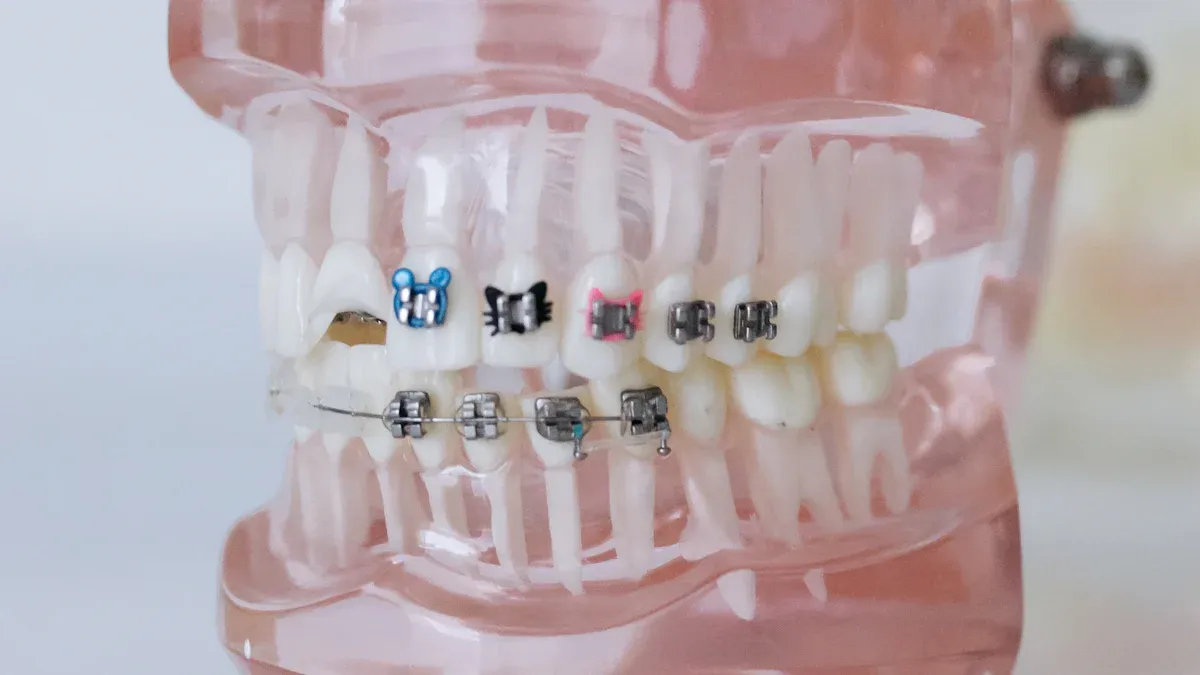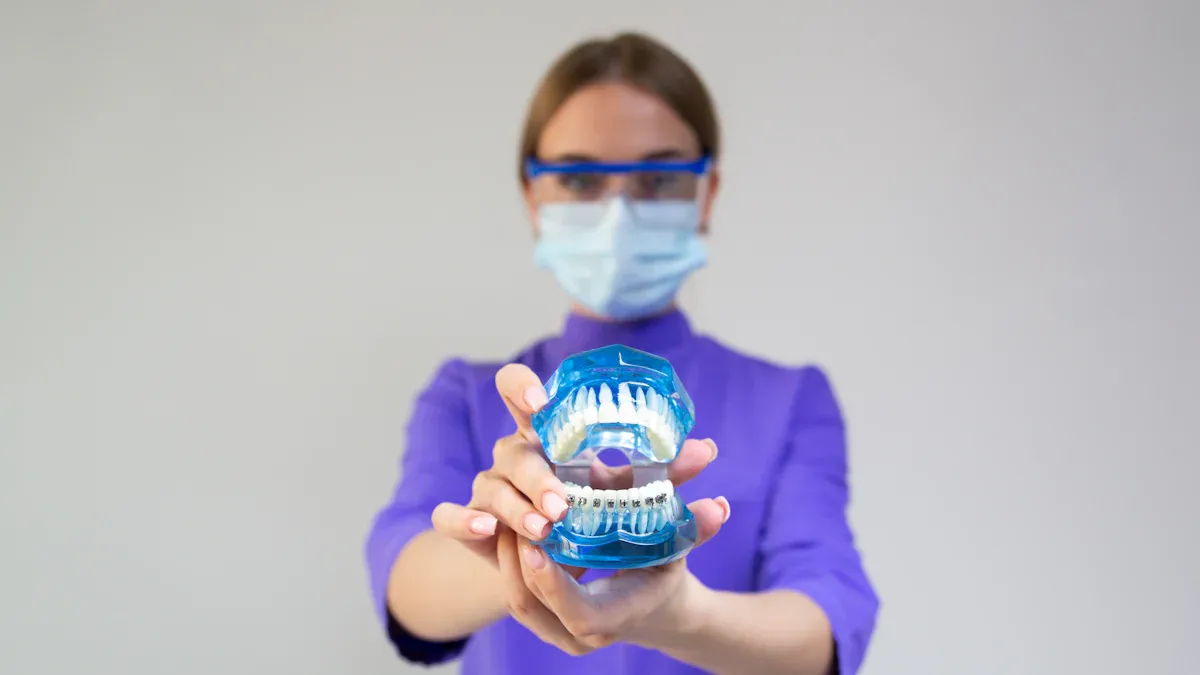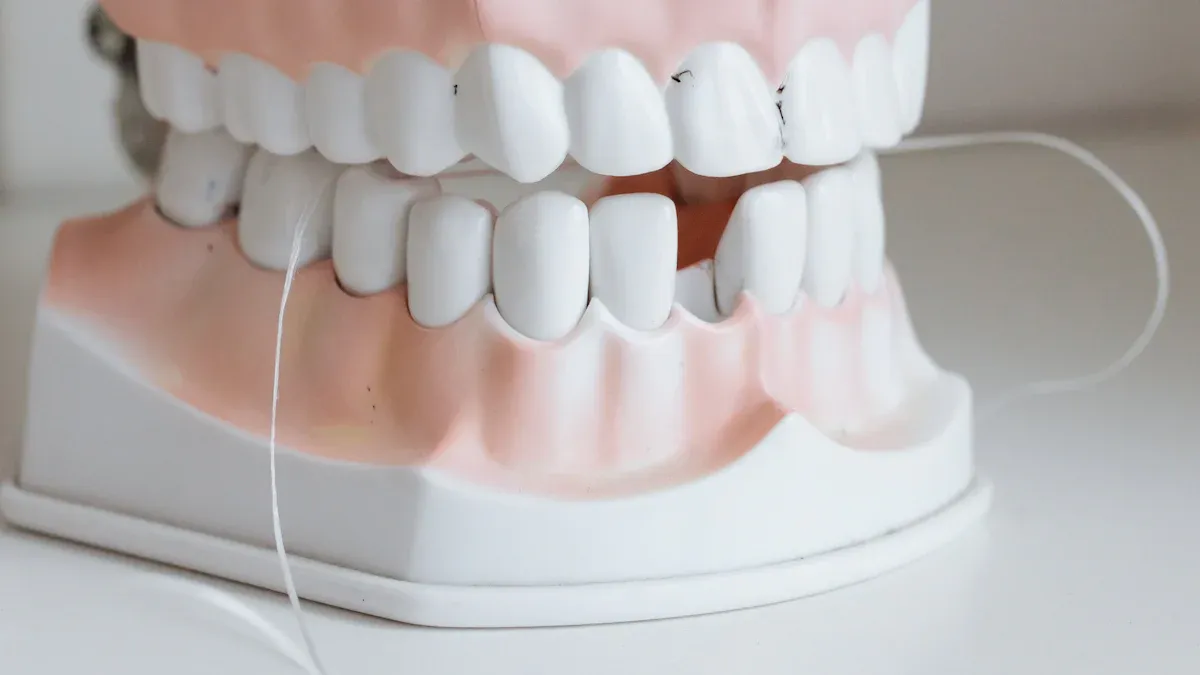What is Nitinol Tubing and How Does It Work in Orthodontic Springs

Nitinol tubing, a nickel-titanium alloy, serves a key role in orthodontic spring Nitinol tubing for orthodontic treatment. Its superelasticity and shape memory allow it to apply gentle, consistent force on teeth. These properties help patients feel less discomfort and need fewer adjustments than with traditional wires. Studies show that Nitinol supports effective tooth movement in orthodontics, with flexible wires that reduce irritation. Choosing the right material can improve comfort and treatment outcomes for every patient.
Key Takeaways
Nitinol tubing has special shape memory and superelasticity that let it gently and steadily move teeth with less pain.
This tubing keeps a constant force over time, so patients need fewer orthodontic visits for adjustments.
Nitinol tubing is very flexible and durable, bending and stretching many times without breaking.
Compared to stainless steel, nitinol tubing causes less irritation and works better for comfortable, effective treatment.
Using nitinol tubing helps orthodontists achieve faster, safer tooth alignment with fewer complications.
Nitinol Tubing

What Is Nitinol
Nitinol is a special nickel-titanium alloy made of about 56% nickel and 44% titanium by weight. Scientists developed this material because it has unique shape memory properties and superelastic behavior. These features make nitinol tubing capability stand out in medical and dental fields. Nitinol wire and tubing can change shape when cold and return to their original form when heated. This happens because nitinol has two crystal structures: martensite at low temperatures and austenite at higher, near body temperature. When used in orthodontics, nitinol tubing and nitinol wire can fit easily into braces and then become strong and flexible once inside the mouth.
Researchers have shown that nitinol is safe for use in the body. It resists corrosion and does not harm human cells. Its biocompatibility and ability to adapt to body temperature make it ideal for orthodontic springs and other medical devices.
Unique Properties
Nitinol tubing has two main features: shape memory properties and superelasticity. Shape memory properties mean that after bending or twisting, the tubing can return to its original shape when warmed. Superelastic behavior allows nitinol wire and tubing to stretch or bend much more than regular metals and snap back without breaking. This superelastic effect is especially useful in orthodontics, where wires need to apply gentle, steady force to move teeth.
Studies using tension–torsion tests on nitinol tubing have shown that it can handle repeated bending and stretching without losing strength. This super-elastic quality comes from the way the crystal structure changes under stress and then returns to normal. Nitinol wire and tubing also show excellent fatigue resistance, which means they last longer even with constant use.
Nitinol’s super-elastic and superelastic properties help orthodontic devices work better and feel more comfortable for patients. The combination of shape memory properties and flexibility makes nitinol tubing a top choice for modern orthodontic treatments.
Orthodontic Spring Nitinol Tubing

How It Works
Orthodontic spring nitinol tubing plays a vital role in modern orthodontics for wires and archwires. Dentists use this tubing to create springs and archwires that move teeth gently and steadily. When placed in the mouth, orthodontic spring nitinol tubing applies a consistent orthodontic force to the teeth. This force remains steady over a wide range of movement, which helps teeth shift into the correct position without causing pain or damage.
Nitinol wire and tubing work differently from traditional materials. Most metal wires, like stainless steel, show a linear increase in force as they bend or stretch. In contrast, orthodontic spring nitinol tubing shows superelastic behavior. This means the tubing can stretch or bend a lot but still return to its original shape. The superelastic effect allows the tubing to deliver a nearly constant orthodontic force, even as the teeth move. This gentle, steady pressure reduces the risk of trauma to teeth and gums.
Nitinol-based orthodontic springs show a superelastic plateau, where the force stays almost the same even as the spring stretches.
Traditional springs made from steel or cobalt chromium nickel increase force as they compress, which can cause discomfort.
Nitinol tubing can handle strains up to 8% without permanent change, while regular metals only manage about 0.8%.
The force/compression curve for nitinol springs includes a hysteresis loop, which means the loading and unloading paths differ due to phase changes inside the metal.
Experimental studies show that nitinol springs maintain more consistent force during both compression and release, though the exact force can vary with design and temperature.
Over time, nitinol springs may lose some force (10%-40%), so dentists must check and adjust them as needed.
Temperature affects the superelastic plateau. Higher temperatures raise the force level but shorten the plateau.
Nitinol tubing batches can vary in force by about ±18%, but sterilization does not change their properties much.
Overall, orthodontic spring nitinol tubing gives more controlled, predictable, and gentle force than traditional metal springs, leading to better orthodontic treatment results.
Biomechanical studies show that nitinol tubing keeps a gentle, steady force because of its superelasticity and phase transformation. When the tubing bends or stretches, it changes from one crystal structure to another. This change lets the tubing deform a lot and then snap back to its original shape. The tubing exerts a small but steady outward force, which helps move teeth safely. At the same time, it resists outside pressure, keeping its shape and function. These properties make orthodontic spring nitinol tubing ideal for orthodontic archwires and springs.
Statistical analysis from clinical trials supports the flexibility and memory return of nitinol in orthodontic applications. One study found that patients with nitinol archwires had teeth align 30% faster in the first six months compared to those with stainless steel wires. This faster alignment comes from the tubing’s ability to keep a gentle, continuous force, thanks to its shape memory and superelasticity. The tubing’s flexibility and memory return help it work better than other materials in orthodontic treatment.
Laboratory and clinical tests measure how nitinol tubing loses force over time. Dynamic Mechanical Analysis (DMA) and Instron machines test the force levels before and after use. These tests show that nitinol tubing loses some force over weeks, but the loss is similar in both lab and real-life settings. This means orthodontic spring nitinol tubing performs reliably in the mouth, keeping a steady orthodontic force for effective tooth movement.
Superelastic Nitinol Tubes
Superelastic nitinol tubes are the heart of advanced orthodontic archwires and springs. These tubes can stretch, bend, and twist much more than regular wires without breaking. At body temperature, superelastic nitinol tubes show their best properties. They can stretch up to 100% in one direction and up to 360% in two directions, making them very flexible for use in the mouth. Bending tests show that these tubes can rotate from 0° to 180° without losing their shape. The fracture limit strain reaches 12%, which means the tubes are very durable before breaking.
Test Type | Key Findings |
|---|---|
Uniaxial stretching | Up to 100% strain displacement |
Biaxial stretching | 300%–360% strain |
Bending test | Rotation from 0° to 180° |
Fracture limit strain | 12% maximum principal strain |
Three-point bending | High flexibility and resistance to deformation |
Deployment force | 0.32–0.42 N (moderate, maintains device integrity) |
Recapture force | 0.035–0.45 N (allows repositioning) |
Clinical studies show that superelastic nitinol tubes work well at body temperature. Devices made from these tubes have a technical success rate of 97% and a treatment success rate of 83%. Major complications are rare, at only 4.1%. The superelasticity and shape memory of these tubes allow them to fit through small spaces and then expand to apply a gentle, steady orthodontic force. This helps move teeth safely and effectively.
Fatigue resistance tests show that superelastic nitinol tubes can last through millions of cycles without breaking. The best manufacturing methods make tubes that last two to three times longer than others. Smaller non-metallic inclusions in the metal improve durability. Some tubes even show matrix healing, which helps them last longer. These features are important for orthodontic archwires, which must work for months or years in the mouth.
A 2014 study tested superelastic nitinol tubes at 37°C, the same as body temperature. The study found that heat-activated superelastic nitinol tubes showed lower forces over a larger range of movement compared to regular austenitic nitinol. This means the tubes recover better and keep their shape, even after bending and stretching. The tubes also show higher mechanical hysteresis, which means they can absorb energy and return to their original form without permanent change.
Super elastic niti wire and superelastic nitinol tubes give orthodontists powerful tools for moving teeth. The tubes’ ability to keep a steady orthodontic force, return to their original shape, and resist breaking makes them the top choice for orthodontic archwires and springs. Patients benefit from faster, more comfortable treatment, while orthodontists can rely on the tubes’ performance and safety.
Why Nitinol
Comparison with Stainless Steel
Nitinol and stainless steel are both popular materials in clinical orthodontics. Each has unique strengths. Stainless steel wires have long been the standard for orthodontic treatment. They offer high strength and predictable force. Multistranded stainless steel wires can match or even exceed the strength and range of some nitinol wires. However, nitinol stands out for its superelasticity and shape memory. These features allow nitinol tubing to deliver a steady force over a wide range of movement.
Laboratory tests show that superelastic nitinol wires can provide constant force during tooth movement. This force remains stable even as the wire bends or stretches. Stainless steel wires, on the other hand, may offer more predictable force stability in some cases. Temperature changes can affect the force delivered by nitinol, which sometimes leads to variability. Despite this, nitinol tubing remains a top choice for many clinical applications because of its flexibility and ability to return to its original shape.
Biocompatibility is another key difference. Nitinol tubing is widely used in CE-marked medical devices because it resists corrosion and causes less tissue irritation. Direct comparison studies show that nitinol stents have 36% less fibrin(ogen) adsorption and 63% less platelet adhesion than stainless steel. This means nitinol has a lower risk of causing blood clots and is safer for use in the body.
Clinical Benefits
Nitinol tubing offers several benefits in clinical application. Patients often experience fewer adjustments during orthodontic treatment. The tubing’s superelasticity helps maintain a gentle, steady force, which can reduce pain and discomfort. Clinical studies show that most patients with nitinol tubing report less severe pain and faster tooth movement compared to those with other wires.
Patient Group | Severe Pain | Insignificant Pain | Tooth Movement (mm/month) |
|---|---|---|---|
Nitinol-only | 5 | 1 | 3.0 - 4.9 |
Dual-wire | 0 | 9 | 6.5 - 7.3 |
Nitinol tubing also shows high technical success rates in clinical application. In one study, 97% of patients had successful outcomes with nitinol devices. The tubing’s durability and biocompatibility help reduce complications and improve patient safety. These features make nitinol a reliable choice for clinical orthodontics.
Nitinol’s unique properties support better comfort, fewer visits for adjustments, and more predictable results in orthodontic treatment.
Practical Benefits
Faster Alignment
Nitinol tubing has changed the way orthodontists approach early alignment and leveling. Many believe that its superelastic properties help teeth move faster and more comfortably. In laboratory tests, nitinol shows strong flexibility and returns to its original shape after bending. This makes it useful for solving tough orthodontic problems, especially during early alignment and leveling.
However, clinical studies have not found clear proof that nitinol tubing speeds up alignment compared to other wires. Researchers found that:
Clinical trials did not show that nitinol tubing leads to faster alignment.
Studies often had problems like bias and did not measure all important outcomes.
Some trials suggested small differences, but the results were weak and unreliable.
Many factors, such as patient age and bracket type, made it hard to compare results.
Despite these findings, nitinol tubing remains popular for early alignment and leveling because it provides gentle, steady pressure. Patients often feel more comfortable during the first stages of orthodontic treatment.
Fewer Adjustments
Nitinol tubing stands out for its ability to keep a steady force on teeth. This means orthodontists do not need to adjust the wires as often. Superelastic nitinol wires apply a continuous force, even after teeth move several millimeters. In contrast, other wires lose tension and need more frequent tightening.
Key benefits include:
Nitinol archwires maintain gentle pressure due to shape memory at mouth temperature.
Stainless steel wires lose force over time, leading to more visits for adjustments.
Superelastic nitinol is much more flexible than stainless steel, which helps keep the force steady.
Patients with nitinol tubing usually need fewer appointments for wire changes.
Nitinol tubing also offers excellent durability. It resists breaking and keeps working for a long time. This durability, along with fewer adjustments, makes nitinol a cost-effective choice for orthodontic care. Patients spend less time in the dental chair and enjoy a safer, more reliable treatment.
Nitinol tubing offers steady force, flexibility, and comfort in orthodontic springs. Patients experience fewer adjustments and faster alignment. Orthodontists trust its durability and biocompatibility. The market for nitinol continues to grow, with medical uses leading at 45% and a projected value of USD 4.1 billion by 2033. These trends show that new technology keeps improving orthodontic care. Patients should talk with their orthodontist about the best material for their treatment.
FAQ
What makes Nitinol tubing different from regular metal wires?
Nitinol tubing has superelasticity and shape memory. These features help it return to its original shape after bending. Regular metal wires do not have these properties.
Is Nitinol tubing safe for use in the mouth?
Researchers have tested Nitinol tubing for safety. It resists corrosion and does not harm human tissue. Dentists use it in many medical devices because of its biocompatibility.
How does Nitinol tubing help with tooth movement?
Nitinol tubing applies a gentle, steady force to teeth. This force helps teeth move into the correct position. The tubing keeps its strength over time, which supports effective treatment.
Do patients need fewer orthodontic visits with Nitinol tubing?
Yes. Nitinol tubing keeps a steady force on teeth. Orthodontists do not need to adjust it as often as other wires. Patients usually have fewer appointments.
Can Nitinol tubing break easily?
Nitinol tubing has high durability. It can bend and stretch many times without breaking. Fatigue resistance tests show that it lasts longer than many other orthodontic materials.
See Also
The Importance Of Nitinol Tubing In Minimally Invasive Surgery
Choosing The Right Nitinol Tubing Supplier For Your Requirements
Finding The Most Cost-Effective 2mm Nitinol Tubing Supplier
A Detailed Process For Making Nitinol Microtubing In Neurovascular Use

